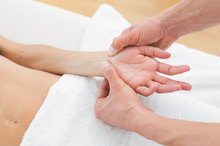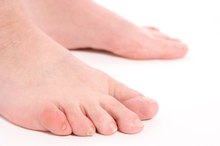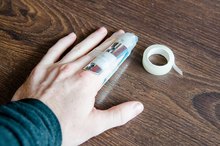Medical Advice for a Smashed Thumb
**At one time or another, most everyone experiences a smashed finger.
If you are experiencing serious medical symptoms, seek emergency treatment immediately.
** The less severe examples of these injuries can easily be treated at home. Other times, medical attention is required. In any case, understanding the injury and knowing how to treat it is necessary. Failing to properly care for a smashed thumb or finger could lead to unnecessary pain, potential infection or even permanent damage to the digit.
Causes
A thumb or finger can be smashed while engaging in nearly any activity. **The most common causes of this type of injury are being closed in a car door, hit with a hammer, shut in a drawer or jammed while playing sports.
** The damage is caused when the digit is caught between more than one heavy object. The impact produces a build up of pressure at the sight of the injury.
- A thumb or finger can be smashed while engaging in nearly any activity.
- The most common causes of this type of injury are being closed in a car door, hit with a hammer, shut in a drawer or jammed while playing sports.
Identification
Home Remedy for a Red & Swollen Fingernail
Learn More
The appearance of a smashed thumb or finger is usually associated with discoloration or bruising around the fingernail and surrounding skin of the digit.
There may also be bleeding, dried blood, numbness and swelling around the injury. In more severe cases, the finger bone might be fractured, as well. There is also the possibility of losing the fingernail. In addition to the bruised and swollen appearance of the smashed thumb, a significant amount of pain and tenderness is present around the thumbnail.
- The appearance of a smashed thumb or finger is usually associated with discoloration or bruising around the fingernail and surrounding skin of the digit.
- In more severe cases, the finger bone might be fractured, as well.
Treatment
Examine the smashed thumb for possible deformities and fractures in the bones. If you suspect that a bone is fractured, seek medical attention to determine the best way to treat the injury.
If there are no broken bones, treat the smashed thumb by applying ice to reduce the swelling and lessen the pain. Use over-the-counter medications to help with the pain. Keep the smashed thumb or finger clean and apply antibiotic ointment and a bandage to protect it from infection.
- Examine the smashed thumb for possible deformities and fractures in the bones.
- Keep the smashed thumb or finger clean and apply antibiotic ointment and a bandage to protect it from infection.
Effects
How to Splint a Strained Thumb
Learn More
The impact that occurs when a thumb is smashed often results in an accumulation of blood under the thumbnail. When this happens, the nail will most likely fall off within a few days or weeks.
Once the fingernail becomes loose or falls off, there is an increased risk of infection to the sensitive, unprotected skin underneath. It's imperative that the injury remains clean and covered. A new nail will soon grow in to replace the old, damaged one.
- The impact that occurs when a thumb is smashed often results in an accumulation of blood under the thumbnail.
- Once the fingernail becomes loose or falls off, there is an increased risk of infection to the sensitive, unprotected skin underneath.
Warning
If the injury affects more than just the tip of the thumb, seek immediate medical assistance. Do not apply a splint to a smashed finger unless directed to do so by a physician. **Splinting a smashed thumb may affect long-term mobility of the digit.
It is also not advisable to attempt to drain a swollen finger or fingernail unless your healthcare provider suggests it. If so, assistance and specific instructions on how to properly carry out the procedure will be provided by the physician. **
- If the injury affects more than just the tip of the thumb, seek immediate medical assistance.
- It is also not advisable to attempt to drain a swollen finger or fingernail unless your healthcare provider suggests it.
Prevention/Solution
Pay closer attention when handling heavy objects and operating doors to the car and home. Also, install safety devices to door, such as self-closing springs which cause the door to close more slowly.
If there are young children in the home, teach them safety tips about using doors, drawers and windows.
Always be aware of where your hands and those of anyone nearby are placed before shutting doors and other possible crushing culprits. Slow down and take your time. The majority of smashed fingers occur when people are careless and preoccupied.
- Pay closer attention when handling heavy objects and operating doors to the car and home.
Related Articles
References
- NIH U.S. National Library of Medicine. Smashed Finger. 2017.
- Warren D. Childhood finger injuries. Paediatr Child Health. 1998;3(2):78-80.
- Hung KKC, Graham CA, Lo RSL, et al. Oral paracetamol and/or ibuprofen for treating pain after soft tissue injuries: Single centre double-blind, randomised controlled clinical trial. PLoS ONE. 2018;13(2):e0192043. doi:10.1371/journal.pone.0192043
- Won SH, Lee S, Chung CY, et al. Buddy taping: is it a safe method for treatment of finger and toe injuries? Clin Orthop Surg. 2014;6(1):26-31. doi:10.4055/cios.2014.6.1.26
- Bonisteel PS. Practice tips. Trephining subungual hematomas. Can Fam Physician. 2008;54(5):693.
- Nelson SW, Gibbs MA. Hand and wrist injuries. In: Adam JG, ed. Emergency Medicine: Clinical Essentials. 2nd ed. Philadelphia, PA: Elsevier Saunders; 2013:chap 89.
- NIH U.S. National Library of Medicine. Smashed Finger. 2015.
Writer Bio
Jo Brielyn began writing professionally in 1992, while serving as a training specialist in the U.S. Air Force, and became a freelance writer in 2007. She is a contributing writer for Hatherleigh Press and has works in several print and online publications. She holds a Bachelor of Science in education, training and development from Southern Illinois University.








